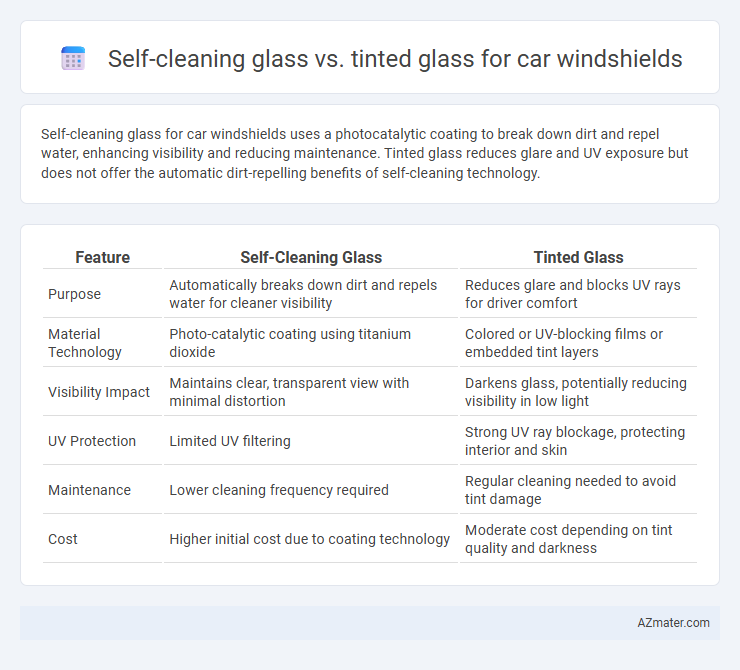Self-cleaning glass for car windshields uses a photocatalytic coating to break down dirt and repel water, enhancing visibility and reducing maintenance. Tinted glass reduces glare and UV exposure but does not offer the automatic dirt-repelling benefits of self-cleaning technology.
Table of Comparison
| Feature | Self-Cleaning Glass | Tinted Glass |
|---|---|---|
| Purpose | Automatically breaks down dirt and repels water for cleaner visibility | Reduces glare and blocks UV rays for driver comfort |
| Material Technology | Photo-catalytic coating using titanium dioxide | Colored or UV-blocking films or embedded tint layers |
| Visibility Impact | Maintains clear, transparent view with minimal distortion | Darkens glass, potentially reducing visibility in low light |
| UV Protection | Limited UV filtering | Strong UV ray blockage, protecting interior and skin |
| Maintenance | Lower cleaning frequency required | Regular cleaning needed to avoid tint damage |
| Cost | Higher initial cost due to coating technology | Moderate cost depending on tint quality and darkness |
Introduction to Modern Car Windshield Technologies
Modern car windshield technologies enhance driving safety and convenience through innovations like self-cleaning glass and tinted glass. Self-cleaning glass features hydrophobic and photocatalytic coatings that repel dirt and reduce maintenance by breaking down organic contaminants using sunlight. Tinted glass improves UV protection, reduces glare, and enhances temperature control inside the vehicle, contributing to both comfort and interior preservation.
What is Self-Cleaning Glass?
Self-cleaning glass utilizes a special photocatalytic coating, typically titanium dioxide, which breaks down organic dirt when exposed to sunlight and allows rainwater to wash it away, reducing maintenance needs. This technology enhances visibility by keeping the windshield cleaner for longer periods without manual cleaning. In contrast, tinted glass primarily focuses on reducing glare and UV radiation rather than dirt management.
What is Tinted Glass?
Tinted glass for car windshields is specially treated with a thin film or coating that reduces glare, blocks harmful UV rays, and improves privacy and comfort. It enhances driving safety by minimizing eye strain and reducing interior heat buildup. Unlike self-cleaning glass, which uses technology to repel dirt and water, tinted glass primarily focuses on light control and temperature regulation.
Benefits of Self-Cleaning Glass for Cars
Self-cleaning glass for car windshields offers significant benefits including reduced maintenance by repelling dirt and water, thereby enhancing visibility and safety during adverse weather conditions. Its hydrophobic and photocatalytic coatings break down organic materials and prevent grime buildup, extending the lifespan of the windshield and preserving optical clarity. Compared to tinted glass, which primarily reduces glare and heat, self-cleaning glass actively maintains cleanliness, providing a clearer view without the need for frequent manual cleaning.
Benefits of Tinted Glass for Windshields
Tinted glass for car windshields significantly reduces glare from sunlight and headlights, enhancing driver visibility and safety. It also blocks up to 99% of harmful UV rays, protecting the car's interior and occupants from sun damage. Additionally, tinted glass helps regulate interior temperature, improving comfort and reducing the need for air conditioning.
Key Differences Between Self-Cleaning and Tinted Glass
Self-cleaning glass for car windshields utilizes a special coating that breaks down organic dirt and repels water, ensuring improved visibility and reduced maintenance. Tinted glass, on the other hand, primarily reduces glare and blocks UV rays to enhance driver comfort and protect the vehicle's interior from sun damage. While self-cleaning glass emphasizes cleanliness and clarity, tinted glass focuses on heat reduction and privacy.
Cost Comparison: Self-Cleaning vs Tinted Windshields
Self-cleaning windshields typically cost between $200 and $400 more than standard glass due to specialized coatings that repel dirt and water, reducing maintenance expenses over time. Tinted windshields generally range from $100 to $300, offering UV protection and glare reduction but requiring less upfront investment compared to self-cleaning options. While self-cleaning glass increases initial costs, it may lower long-term cleaning and replacement expenses, whereas tinted glass offers a more budget-friendly solution focused on comfort and aesthetics.
Maintenance and Durability Considerations
Self-cleaning glass for car windshields reduces maintenance by utilizing a photocatalytic coating that breaks down organic dirt and enables rainwater to wash away debris, leading to longer-lasting clarity with minimal effort. Tinted glass, while effective at reducing glare and UV exposure, requires careful cleaning with non-abrasive materials to prevent scratches and potential damage to the tint film, impacting durability over time. Both options enhance windshield longevity, but self-cleaning glass offers superior ease of upkeep compared to the delicate maintenance demands of tinted glass.
Safety and Legal Aspects for Car Windshields
Self-cleaning glass enhances safety by maintaining clearer visibility in various weather conditions through its hydrophobic and photocatalytic coatings, reducing the need for manual cleaning while complying with standard windshield transparency regulations. Tinted glass improves glare reduction and UV protection, contributing to driver comfort and eye safety, but must conform to specific legal limits on darkness and reflectivity to ensure sufficient visibility for law enforcement and emergency responders. Both options require adherence to regional safety standards like FMVSS 205 in the US or ECE Regulation 43 in Europe to guarantee that windshield performance does not compromise driver vision or legal compliance.
Choosing the Right Glass Technology for Your Car
Choosing the right glass technology for your car windshield depends on factors like maintenance and visibility. Self-cleaning glass uses a photocatalytic coating that breaks down organic dirt with sunlight, reducing cleaning frequency and enhancing clarity during rain. Tinted glass blocks UV rays and reduces glare, improving driver comfort and protecting the interior while offering privacy, making it ideal for sunny environments.

Infographic: Self-cleaning glass vs Tinted glass for Car windshield
 azmater.com
azmater.com